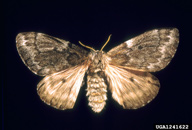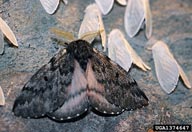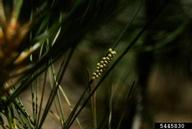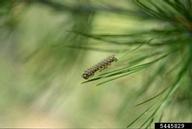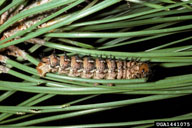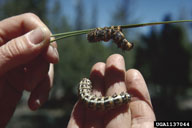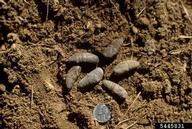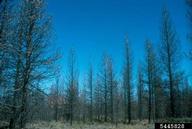Pandora moth
Coloradia pandora Blake (Lepidoptera: Saturniidae)
Orientation to pest
Pandora moth, Coloradia pandora Blake, is an important defoliator of pines in the western United States. There are three recognized subspecies. Two years are needed to complete the life cycle. Adults appear in spring or early summer and eggs hatch in August. Larvae crawl up trees and young larvae feed in groups on new foliage. Immature larvae spend the winter hibernating in clusters at the base of the needles and resume feeding the following spring. In June of the second year, mature larvae crawl down trees and pupate in earthen cells in the ground. Adults may emerge the following year, or remain as pupae for up to five years. Outbreaks occur in regions with soils loose enough for larvae to bury themselves for pupation, these being chiefly pumice or decomposed granite soils. Large and economically important outbreaks have occurred in the past and these seem to reoccur at 20-30 year intervals, lasting 6 to 8 years each. Because each generation requires two years for completion and populations are synchronized, feeding is concentrated in alternate years, which allows many trees to recover and survive. In non-outbreak years, this insect is uncommon.
Hosts commonly attacked
This species feeds primarily on ponderosa (Pinus ponderosa Douglas ex C. Lawson), lodgepole (Pinus contorta Douglas) and Jeffrey (Pinus jeffreyi Balf.) pines, but other pines are also sometimes attacked.
Distribution
This species occurs in the United States west of the Rocky Mountains, except for Idaho and Washington.
Images of Pandora moth
| Figure 1. Adults of Pandora moth, Coloradia pandora (female, left; male, right) | Figure 2. Eggs of Pandora moth | |
| Figure 3. Young larvae of Pandora moth (left), and older larvae (center and right). Note: upper larvae in right photo is infected with a virus. | ||
| Figure 4. Pupae of Pandora moth | Figure 5. Ponderosa pines defoliated by Pandora moth |
Important biological control agents related to this pest species
During epidemics, populations of Pandora moth are affected by many natural mortality factors, including a wilting virus (likely a polynucleohedrosis virus) of the mature larvae, small mammal predators of the pupae in the soil, and various parasitoids.
Web links for information on Pandora moth
- Forest Insect & Disease Leaflet 114 | USDA Forest Service
- Full Text of Forest Insect & Disease Leaflet 114 | USDA Forest Service
Articles
- Schmid, J. M. and D. D. Bennett. 1986. The North Kaibab Pandora moth outbreak 1978-1984. USDA Forest Service, Rocky Mountain Forest and Range Experiment Station, General Technical Report RM-153, 18 pp. Fort Collins, Colorado, USA.
- Speer, J. H., T. W. Swetnam, B. E. Wickman, and A. Youngblood. 2001. Changes in Pandora moth outbreak dynamics during the past 622 years. Ecology 82: 679-697.
- Speer, J. H. and R. L. Holmes. 2004. Effects of Pandora moth outbreaks on ponderosa pine wood volume. Tree-Ring Research 60: 69-76.
